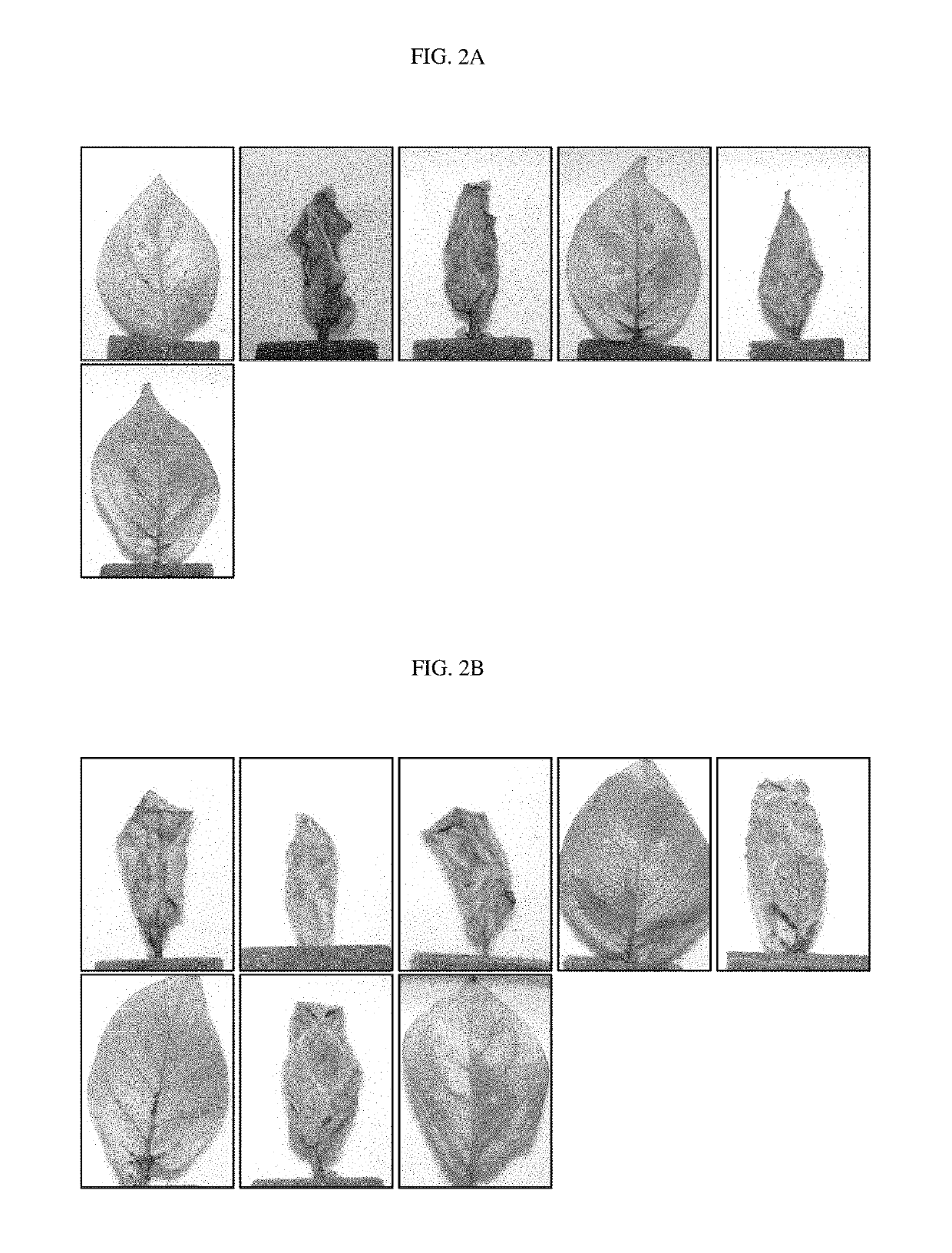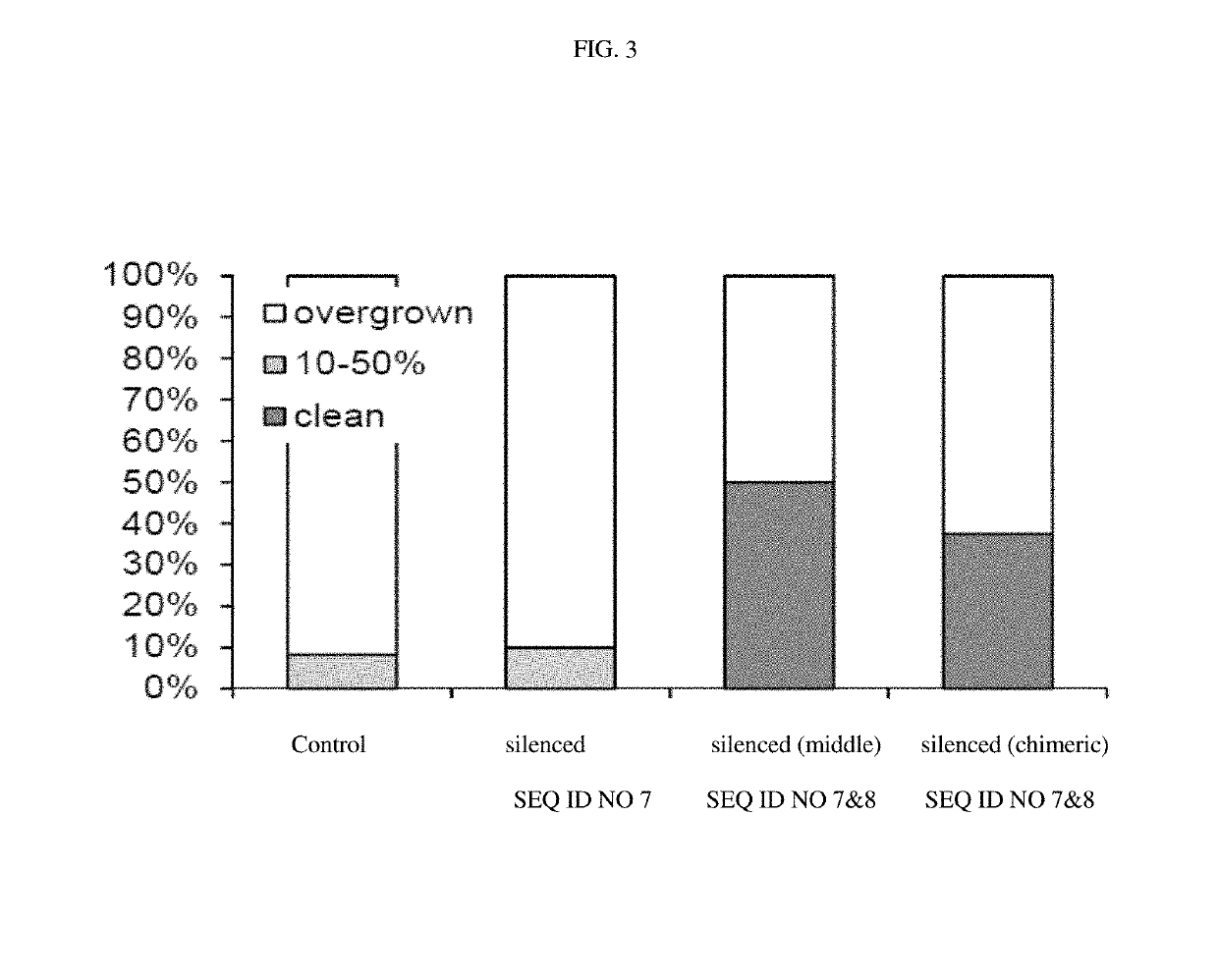Phytophthora resistant plants belonging to the solanaceae family
a technology of solanaceae and phytophthora, which is applied in the field of phytophthora resistance plants belonging to the solanaceae family, can solve the problems of long-standing problems of the agricultural industry, large economic losses on crops worldwide, and environmental damage in natural ecosystems
- Summary
- Abstract
- Description
- Claims
- Application Information
AI Technical Summary
Benefits of technology
Problems solved by technology
Method used
Image
Examples
example 1 (
Potato)
RNAi Constructs Targeting Potato SEQ ID NOS. 7 and 8
[0034]3 different RNAi constructs were made, harboring / targeting:[0035]1. 5′ end of SEQ ID NO 7: equivalent to coding sequence −159-200[0036](−159 from start means in 5′utr).[0037]2. Chimera of 5′ end of SEQ ID NOS. 7 and 8: equivalent to coding sequence 4-199+1-204.[0038]3. Middle part of SEQ ID NO. 7 (highly homologous to middle of SEQ ID NO 8): equivalent to coding sequence 334-743.
[0039]The fragments were amplified from genomic DNA and cloned into the pENTR-D-TOPO vector. For the chimeric construct, 2 fragments were coupled using primers with complementary overhangs, and subsequent extension and amplification to create the fused fragment. Fragments were transferred using a Gateway LR reaction to the RNAi vector pK7GWiWG2 (Karimi et al., 2002, Trends Plant Sci 7), creating an inverted repeat with hairpin structure. Because the pK7GWiWG2 vector requires Streptomycin for bacterial selection, and the Agrobacterium strain use...
example 2 (
[0042]Transposon insertion lines were identified from a collection / library (Vandenbussche et al., 2008, Plant Journal 54). 2 dTph1 transposon insertion alleles were found in SEQ ID NO 9 and 3 dTph1 transposon insertion alleles in SEQ ID NO 10. Several crosses were made to generate double mutants.
Phytophthora Nicotianae Assay Details
[0043]Plants were grown in standard potting soil, individually potted, at 23°C.
P.nicotianae spores were harvested from cultures (lima-bean-agar or V8-agar plates), and 2 ml of spore suspension containing 10e4 (assay Sept) spores was dripped onto the soil with each plant. Plant collapse was monitored regularly.
[0044]As shown in FIG. 4, double mutants, i.e. plants having mutations in both SEQ ID NO 9 and SEQ ID NO 10 have a percentage of living plants of 45%, whereas the percentage of living plants of single mutants (mutant in SEQ ID NO. 9 or SEQ ID NO. 10) is only 20%.
example 3 (
Tomato)
[0045]Tomato plants were transformed with two constructs, either for providing over expression of both SEQ ID NO. 11 and 12, or for providing silencing of both SEQ ID NO. 11 and 12.
[0046]Tomato SEQ ID NO. 11 silencing constructs were generated using Gateway cloning of a 300 bp fragment identical to the middle part of the CDS of SEQ ID NO. 11.
Sequence:
[0047]
(SEQ ID NO: 15)TTGGGTGAACAAGGACAACATATGGCTATCAATTATTATCCTCCTTGTCCACAACCAGAACTTACTTATGGGCTTCCGGCCCATACTGATCCAAATTCACTTACAATTCTTCTTCAAGACTTGCAAGTTGCGGGTCTTCAAGTTCTTAAAGATGGCAAATGGTTAGCTGTAAAACCTCAACCTGACGCCTTTGTCATTAATCTTGGGGATCAATTGCAGGCAGTAAGTAACGGTAAGTACAGAAGTGTATGGCATCGAGCTATTGTGAATTCAGATCAAGCTAGGATGTCAGTGGCTTCGTTT
Using primers:
S. lycopersicum AttB1-F(SEQ ID NO: 13)aaaaagcaggcttcttgggtgaacaaggacaaca S. lycopersicum AttB2-R(SEQ ID NO: 14)agaaagctgggtaaaacgaagccactgacatcc
[0048]The generated ENTRY vector was Gateway cloned into the pHellsgate 12 binary vector. Following Agrobacterium transformation according standard procedu...
PUM
| Property | Measurement | Unit |
|---|---|---|
| RH | aaaaa | aaaaa |
| size | aaaaa | aaaaa |
| resistance | aaaaa | aaaaa |
Abstract
Description
Claims
Application Information
 Login to View More
Login to View More - R&D
- Intellectual Property
- Life Sciences
- Materials
- Tech Scout
- Unparalleled Data Quality
- Higher Quality Content
- 60% Fewer Hallucinations
Browse by: Latest US Patents, China's latest patents, Technical Efficacy Thesaurus, Application Domain, Technology Topic, Popular Technical Reports.
© 2025 PatSnap. All rights reserved.Legal|Privacy policy|Modern Slavery Act Transparency Statement|Sitemap|About US| Contact US: help@patsnap.com



